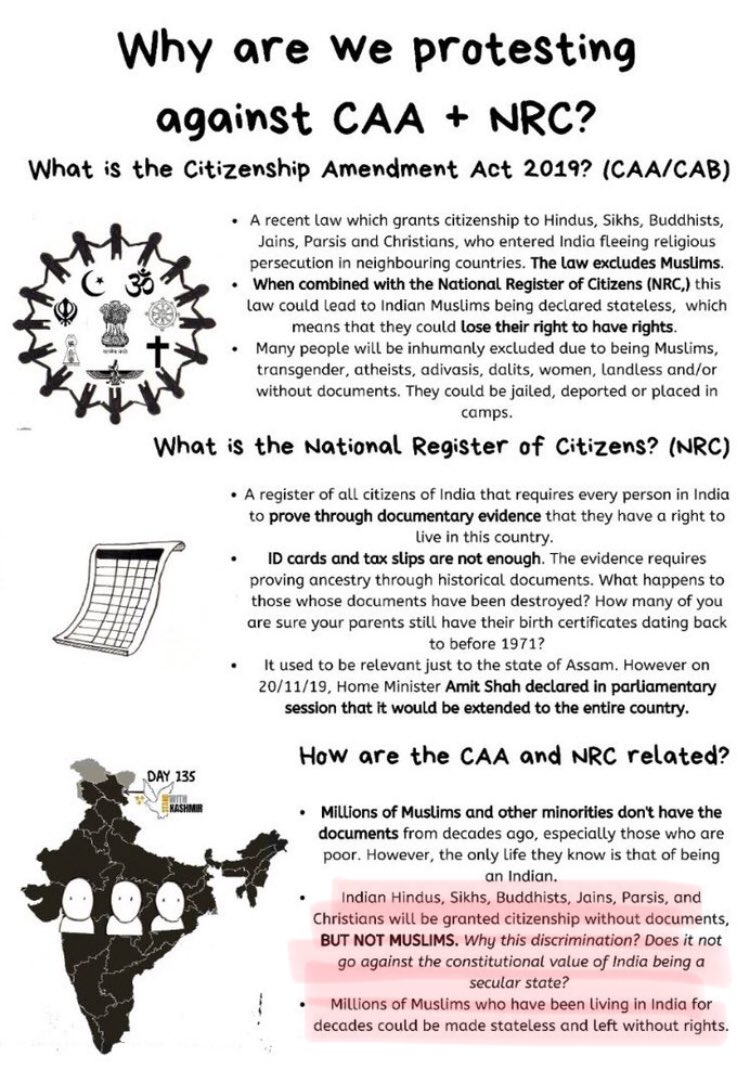1/n #SadarPranam to Ishvara within you @FarOutAkhtar ji. It wasn’t just the inaccurate map but whole poster was anti-India Propoganda. Let me make you aware since @Javedakhtarjadu uncle didn’t. Read the whole thread below👇🏼@TVMohandasPai
https://twitter.com/FarOutAkhtar/status/1207215257220980736
2/n Here is your tweet & poster for which you gave clarifications.
Lets begin clarifying the the highlighted part @FarOutAkhtar .
#CAA doesn’t apply to any Indian not even Hindus so how does it exclude Indian Muslims? Pl clarify for u have added unrest for useless thing.

Lets begin clarifying the the highlighted part @FarOutAkhtar .
#CAA doesn’t apply to any Indian not even Hindus so how does it exclude Indian Muslims? Pl clarify for u have added unrest for useless thing.
https://twitter.com/FarOutAkhtar/status/1207143874138910720

3/n @FarOutAkhtar when #CAA is combined with #NRC only Hindus,Buddhists,Jains,Sikhs,Parsis & Christians frm Afghanistan,Bangladesh,Pakistan who have come to India before 31-12-2014 get its benefit. Every other Indian including Muslims have to go through same procedure as Hindus. 

4/n @FarOutAkhtar ,Indian state has never made distinction against transgender, Aadiwasis, Dalits, Women in terms of citizenship. Perhaps u miss to understand that they too are Hindus. So even if ur flawed case is considered that it favours Hindus they aren’t going to be left out 

5/n @FarOutAkhtar what is this? They could be jailed? Where did you get this information from?
The draft of #NRC isn’t even out so how can you vilify State & make such malicious charges?
Keep reading, I’m updating more lies of your in thread.
The draft of #NRC isn’t even out so how can you vilify State & make such malicious charges?
Keep reading, I’m updating more lies of your in thread.

6/n @FarOutAkhtar ,who told the ISI that ID documents won’t hold good? Rather than following ISI instructions can you pl refer to @HMOIndia & @PIBHomeAffairs . They have made it very clear that no ancestry record is required. 1971 was cut off for Assam for obvious reasons. 

7/n @FarOutAkhtar , @PIBHomeAffairs clarified it 2 days back that no Indian Citizen is required to prove ancestry & very common documents talking of DoB & PoB can suffice requisite for #NRC .Moreover still the draft of All India NRC isn’t out, so why lie?
indiatoday.in/india/story/no…
indiatoday.in/india/story/no…
8/n Yes @FarOutAkhtar @HMOIndia did say #NRC will be applied Pan-India. But when did he say it will be same as that of Assam? Rather all concerned officials have clarified that NRC will be way simpler with very regular documents & also “two witness”scheme for illiterates. 

9/n @FarOutAkhtar why on earth you got trapped in this ISI propaganda? As explained earlier #CAA when combined with #NRC doesn’t affect any Indian Muslim.
Are you a kindergarten kid that you don’t understand that even an Indian Hindu can’t be saved by #CAA ?
Are you a kindergarten kid that you don’t understand that even an Indian Hindu can’t be saved by #CAA ?

10/n @FarOutAkhtar please explain & clarify how an Indian Hindu,Christian,Sikh,Parsi,Jain,Buddhist get Citizenship under #CAA ? In case of lack of document how will he prove to have come from Pakistan,Afghanistan or Bangladesh before 31-12-2014?
Do you understand your mistake?
Do you understand your mistake?

N/n So @FarOutAkhtar instead of fear-mongering you should take lead to make people aware, considering you are a public figure.
Most respectfully I request you to apologise for your misinforming tweet & kindly pull it down in larger benefit of India.
Most respectfully I request you to apologise for your misinforming tweet & kindly pull it down in larger benefit of India.
https://twitter.com/faroutakhtar/status/1207215257220980736?s=21
https://twitter.com/FarOutAkhtar/status/1207215257220980736
• • •
Missing some Tweet in this thread? You can try to
force a refresh































